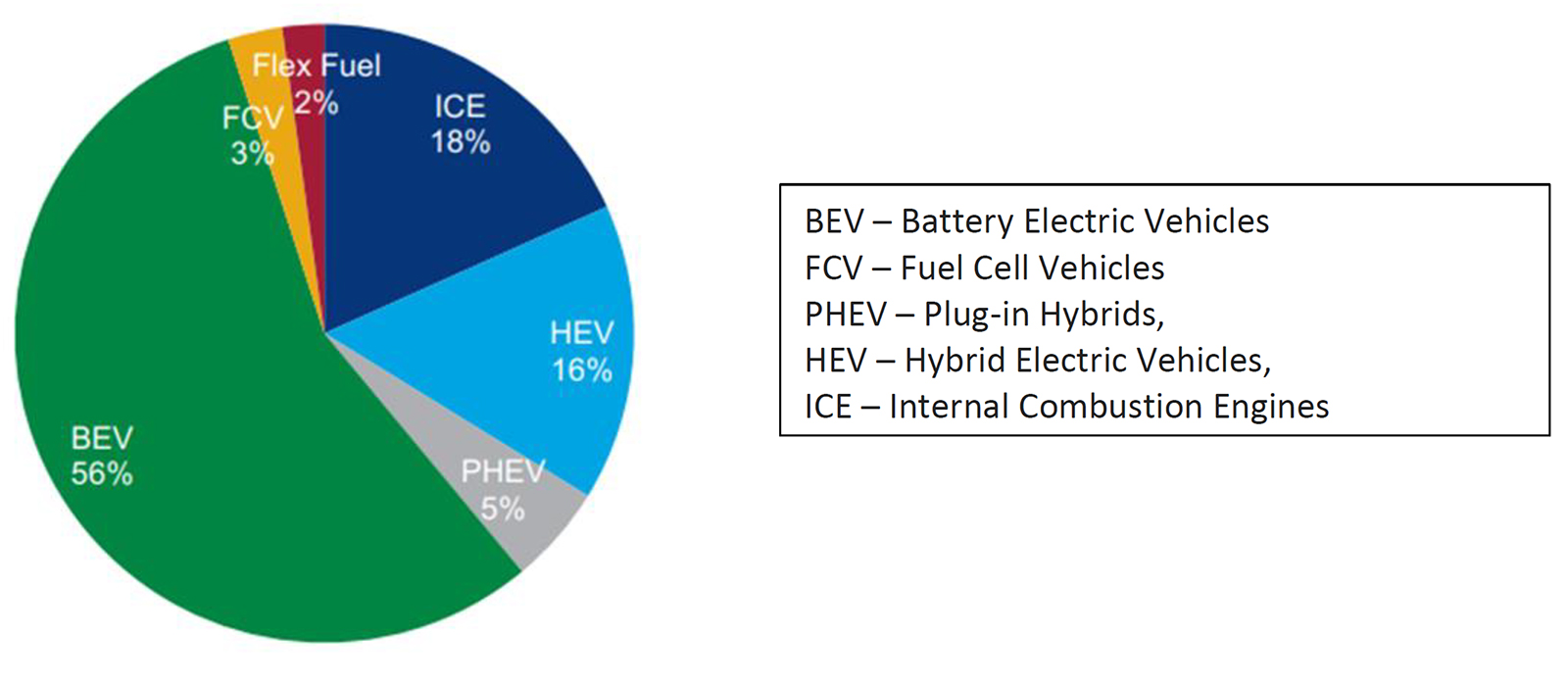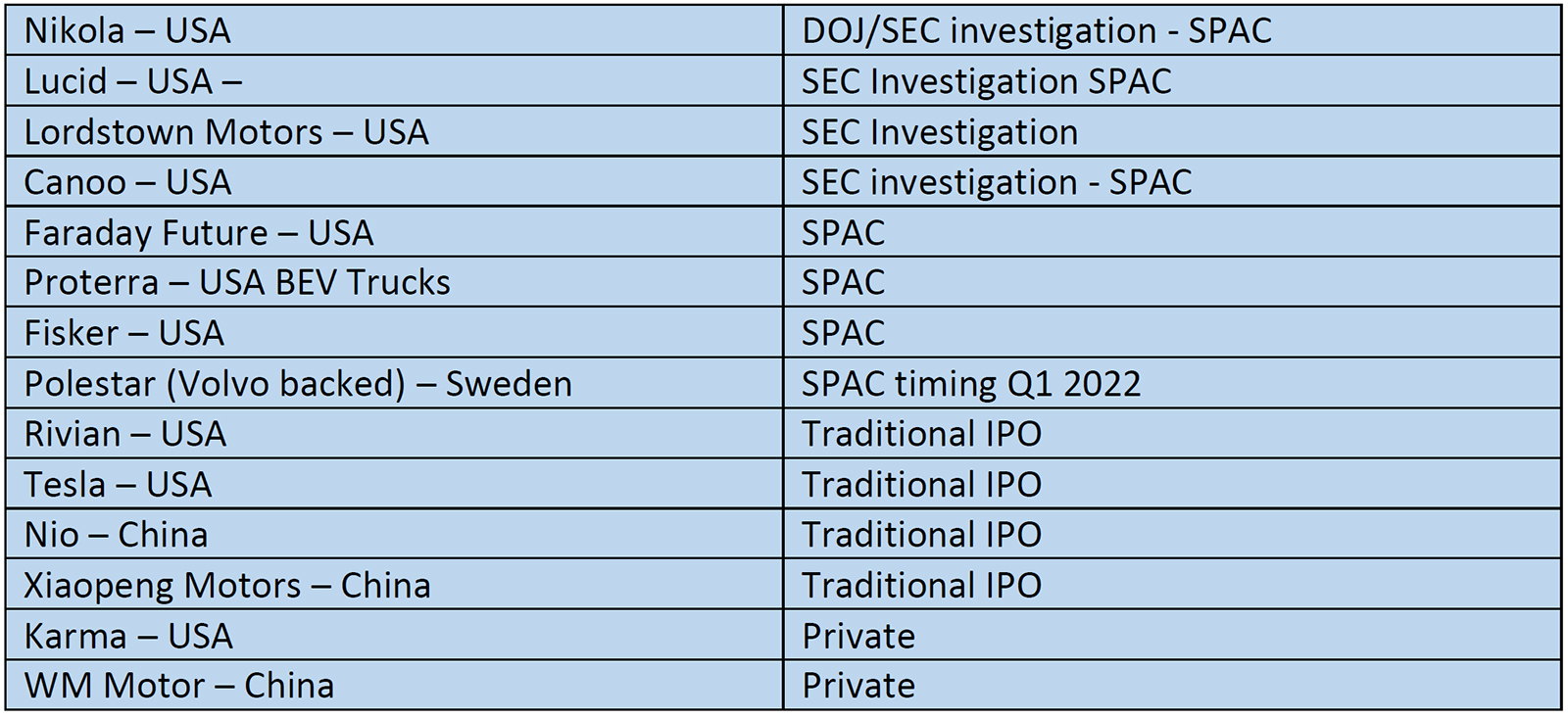As 2022 comes upon us, so do the countless projections for Battery Electric Vehicles (BEV) sales. Every major car manufacturer has put out statements of lofty goals around production output, battery range and prices, among others. Most importantly, many have set goals regarding ceasing the production of internal combustion engines (ICE). Recent research by Wood Mackenzie, a consultancy group based in Edinburgh, Scotland, predicted that annual BEV sales will reach 62 million by 2050–at which time some 700 million BEVs will be on the roads. Auto sales in Europe (86%), China (81%) and North America (78%) will be dominated by BEVs by that time, the group estimates.
My intent here is to take a 30,000 foot view of the burgeoning BEV industry to try and make sense of what the consensus is, if any, for the future of automotive production and the incentives attempting to drive consumer adoption.
Global Forecast
Research firm Wood Mackenzie estimates that more than three out of every five vehicles on the roads will be electric vehicles in China, Europe and the US by 2050. Almost one in two commercial vehicles will be electric by the same date in those regions. Below are their market share estimates for each type of motor designs in 2050.

Source: Wood Mackenzie Energy Transition Service
Who Makes BEVs? – More Companies Than You May Realize.
It didn’t take long to come up with the list below of startup and recently established BEV manufacturers. Many I had never heard of and of course those that we are all familiar with. I am sure I have missed some. It’s a wild west out there. You can also add every major car manufacturer in the world to the list. I did note one aspect to the list of startups below and that is how many startups came public through a now heavily scrutinized method of using a Special Purpose Acquisition Company (SPAC). As you can see, no less than 7 companies used SPACs and one more trying. And as you can see, several are under investigation for violation of securities laws with Nikola drawing the attention of the Dept. of Justice as well. Not a good track record for BEV startups. It doesn’t help build confidence in startup EV companies.

The interesting aspect to me, outside of Tesla, is that all the major automotive companies are a long way from having any material impact on the number of BEVs sold over the next 1-2 years and maybe longer, in my estimation.
The Majors – What Are They Saying?
General Motors
- GM is spending about half its capital over the next few years on BEV and autonomous- driving technologies. By 2030, ICE powered cars won’t look as attractive, relatively speaking, as those programs are drained of resources.
- The company has committed to spending about $27 billion between 2021 and 2025 to launch 30 BEV models around the globe. And it has said it aims to be selling only BEVs by 2035.
Ford
- Ford plans to increase its production capacity of electric vehicles to 600,000 units globally by 2023, according to CEO Jim Farley. He even says that Ford aims to be the second-largest BEV producer within “the next couple of years.”
- Ford’s goal for 40% of its sales to be all-electric vehicles by 2030.
- Ford is investing $22 billion in electrification through 2025 as part of its plan to lead electrification in areas of strength. The company is electrifying its most iconic products – the Mustang, F-150 and Transit – with many more to come in the years ahead.
Stellantis (aka Chrysler, Dodge, Jeep, Ram)
- The company says it is “targeting over 70% of sales in Europe and over 40% in the United States to be low-emission vehicles by 2030.”
- They plan to get there with a combination of electric vehicles (BEVs) and plug-in hybrids (PHBEVs). In the shorter term, plug-in hybrid versions of existing models will dominate.
- Currently, they have no BEVs on the market.
Volkswagen (VW, Porsche, Audi, Lamborghini, Bentley, Ducati, Škoda, Scania)
- Half of Volkswagen’s sales are expected to be battery-electric vehicles by 2030.
- By 2040, the company said almost 100% of its new vehicles in major markets should be zero-emission vehicles.
- Those objectives are part of Volkswagen’s wider aim to be fully carbon neutral by 2050.
BMW (incl Mini’s)
- The company wants fully electric vehicles to represent at least 50% of its deliveries by the year 2030.
- BMW said about 90% of its vehicle lines will have all-electric models ready by 2023.
- The MINI brand will be fully electric “by the early 2030s.”
Mercedes-Benz
- By 2022, Mercedes plans to have BEVs in all segments the company serves.
- From 2025 onwards, all newly launched vehicle architectures will be electric-only and customers will be able to choose an all-electric alternative for every model the company makes.
- Plans are to be all electric by 2030 with the caveat “..where market conditions allow.”
- In total, Mercedes investments into battery electric vehicles between 2022 and 2030 will amount to over €40 billion (US$45 billion).
Toyota
- Toyota plans to have 40% of new global vehicle sales be electrified models by 2025 and increase that proportion to 70% by 2030.
- The company said it will reach 3.5 million BEVs annually by 2030, with 30 models across both Toyota and Lexus brands,
- They plan to invest $35 billion in BEVs after falling well behind the competition in the category.
Honda
- So far, Honda’s focus is strictly on China.
- They plan to introduce 10 Honda-brand EV models in the next five years, but only in China. They have stated that it “envisions exporting these models from China” as well… someday.
- While the company has goals to have 100% electric sales by 2040, a huge chunk of that strategy includes Hydrogen Fuel Cell vehicles.
- Expectations are that its “first volume BEV,” the Prologue, will come to the US in 2024, and will be based on GM’s Ultium electric platform.
- They anticipate a total of 500,000 BEV sales by 2030.
Acura
- A report from Automotive News claims the Japanese premium brand won’t follow Honda’s strategy of launching hybrid vehicles before moving to battery-powered cars later this decade. Instead, Acura will largely skip that phase, except for the MDX and NSX models, and push the launch of electric vehicles more quickly.
- Acura will launch its first electric vehicle in 2024, which will be based on General Motors’ Ultium platform. Essentially the same platform Honda will be getting.
- Acura wants to sell 30,000 units per year. By 2030, the automaker wants to have at least half of its total sales to be electric vehicles.
Nissan
- The company has said it will spend $17.6 billion over the next five years to accelerate the roll-out of electric vehicles.
- Nissan said it will produce 23 new electrified models by 2030, 15 of which will be fully electric.
- Globally, the company is targeting a 50 percent electrification mix for its Nissan and Infiniti brands by the end of the decade.
- In the US, Nissan plans to take things a little slower, only targeting 40 percent of its sales to be EVs by 2040.
I could continue with Subaru, Volvo, Hyundai, Kia, Mazda, and more but I think the message is clear. We will be bombarded with a hundred or more new BEV models, among several other types of alternatives to gas, (I lost track) between now and 2030. It is interesting to note that many car manufacturers are anticipating they will be all electric by 2030 to 2040. Time will tell.
Government BEV Incentives
There are several financial incentives in the form of tax credits. President Biden’s Build Back Better (BBB) Plan includes significant changes in the federal EV credit program. The credit amount is proposed to increase to $12,500 from $7,500 and can be refunded which is a big change given any unused credit in the current form must be carried forward. The proposed increase would only apply to cars made in the US by a union workforce. I can say with some high level of certainty that these proposals will not be become law given how the BBB Plan in its current form is dead on arrival.
Currently, the largest available credit comes from the federal government. It is a bit complicated but can be narrowed down to the following factors:
- Max Credit is $7,500 and is non-refundable. Any unused credit against federal income tax owed carries over to the following year.
- Phases out after a particular manufacturer hits sales of 200,000 BEVs on a cumulative basis beginning January 1, 2010
- Once that threshold is met, cars bought within 6 months of hitting that threshold get 50%, or $3,750.
- It drops to $1,875 in the following 6 months before phasing out completely.
State Tax Credit Incentives
There are too many varying incentive programs among the states to review here. In summary:
- Forty-five states and the District of Columbia provide an incentive for certain EVs and/or PHEVs, either through a specific utility operating in the state or through state legislation.
- The incentives range from tax credits (some refundable) to rebates.
- Many have timeframes stretching out 2-3 years where the incentives are gradually reduced to zero.
- No state has an incentive that is as generous as the federal incentive.
Car Manufacturers That Still Qualify for Tax Credits
As mentioned above, when cumulative EV sales for a car manufacturer reach 200,000, the federal credits quickly phase out. Below is a list of major car companies that have cars that still qualify for the federal credit:
| Audi | BMW | Chrysler | Ford | Honda | Hyundai |
| Jeep | Kia | Land Rover | Lincoln | Mazda | Mercedes-Benz |
| Mini Cooper | Porsche | Subaru | Toyota | VW | Volvo |
Noticeably missing are Tesla and General Motors both of which have hit the threshold of cars sold so no longer qualify for federal credits along with many state and utility credits. If the car is re-sold, any remaining credit not used up by the original owner is not carried over the second owner.
Batteries and Charging Times – The Holy Grail of BEVs
For the sake of brevity, the development new battery technology is moving at a very fast pace. Tesla’s dominance will continue over the next couple of years on the battery front. There are too many other battery development efforts going on around the globe to even think about. What is clear though, such technology will likely be the most differentiated aspect across the BEV industry and be the most likely bottleneck to accelerating the production of cars.
Shortening the time it takes to fully recharge (or partially recharge) a battery and extending the range of the charge are the benchmarks of success that all companies are competing against. Those two factors are at the top of the list for anyone considering the purchase of a BEV. There will also have to be hundreds of thousands of charging outlets in place. Forecasts suggest there will be over 550 million charging outlets in place globally by 2050 with 90% being residential chargers.
What is the Outlook for Internal Combustion Engines?
Again, for the sake of brevity, it is very safe to say that ICE powered vehicles are not going away anytime soon. I have read several articles on this question, and you can be assured technological advancements on multiple fronts are making ICEs significantly more efficient and environmentally safe. Some argue they will become better for the environment than batteries in terms of reducing greenhouse gases and overall waste issues surrounding what to do with depleted batteries. That said, research firm Wood Mackenzie forecasts sales of ICE powered vehicles, including micro/mild hybrids, will fall to under 20% of all global sales by 2050. They estimate that half of those remaining sales will largely be in underdeveloped regions including Africa, the Middle East, Latin America and Russia.
Wrapping Up
In the midst of the current environment, we are encouraged with the ongoing strong economic growth which should bode well for the markets in 2022. That said, we expect the markets to experience more volatility than we have seen over the past year. The mega-cap technology companies that have led for so long are beginning to lose some steam given such lofty valuations relative to future earnings growth. We are monitoring market action closely and are making changes in portfolio allocations when appropriate.
Saying goodbye to 2021. Our hope is that all of you came through the year healthy and safe and for those who experienced the impacts of the virus, our thoughts are with you. We are encouraged by the ongoing efforts to contain and irradicate the virus, but we all know there remains a long way to go.
